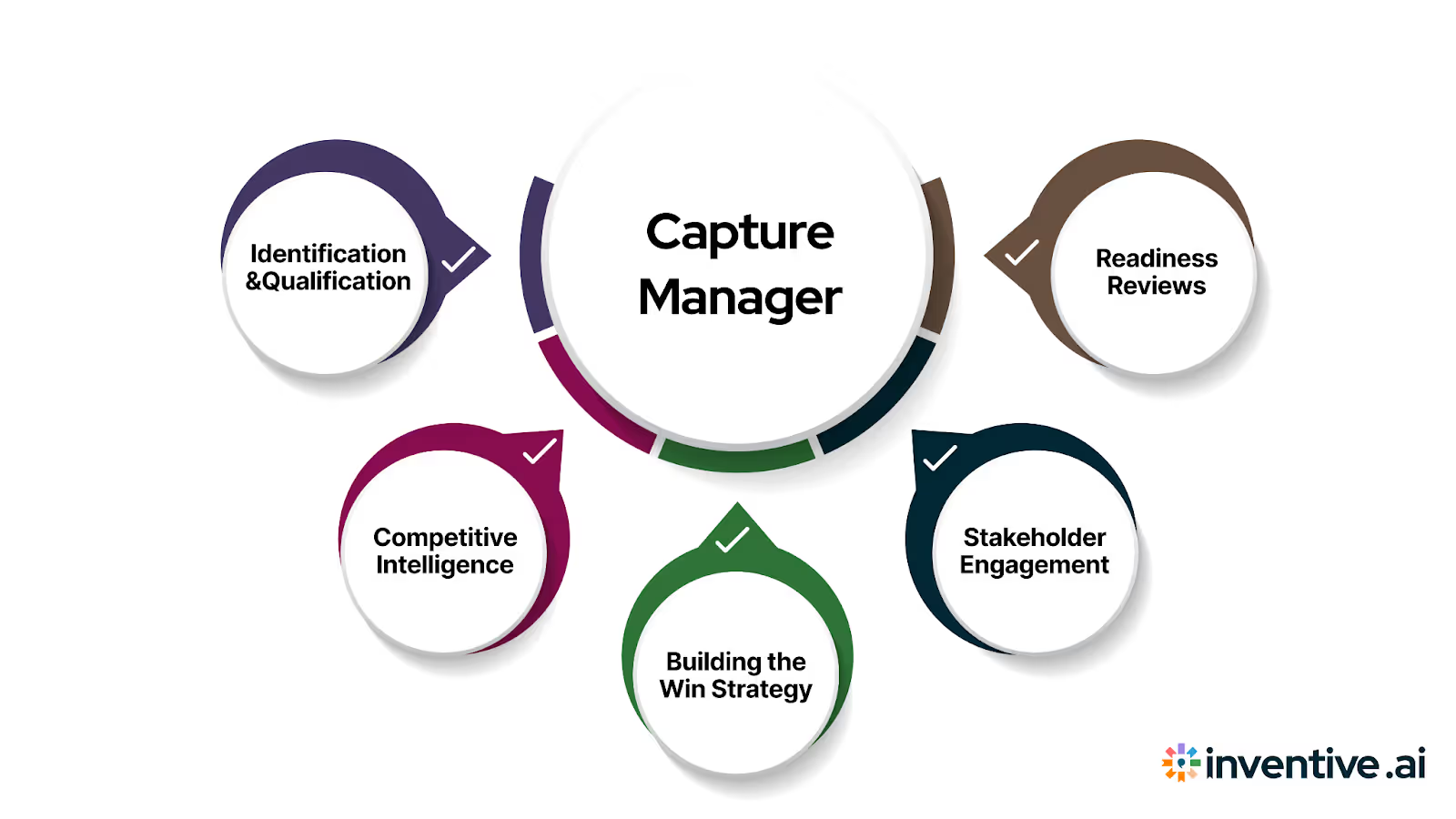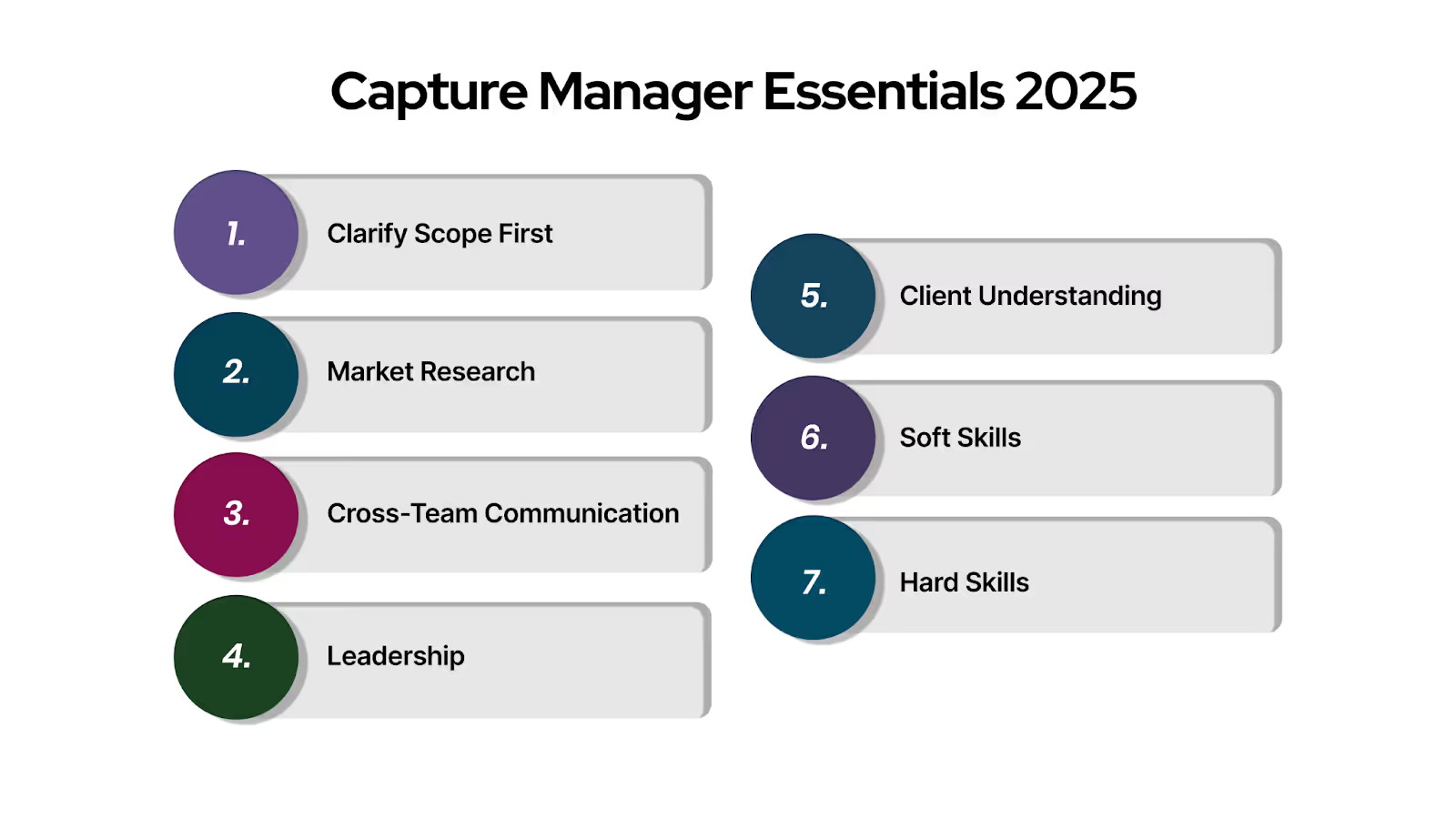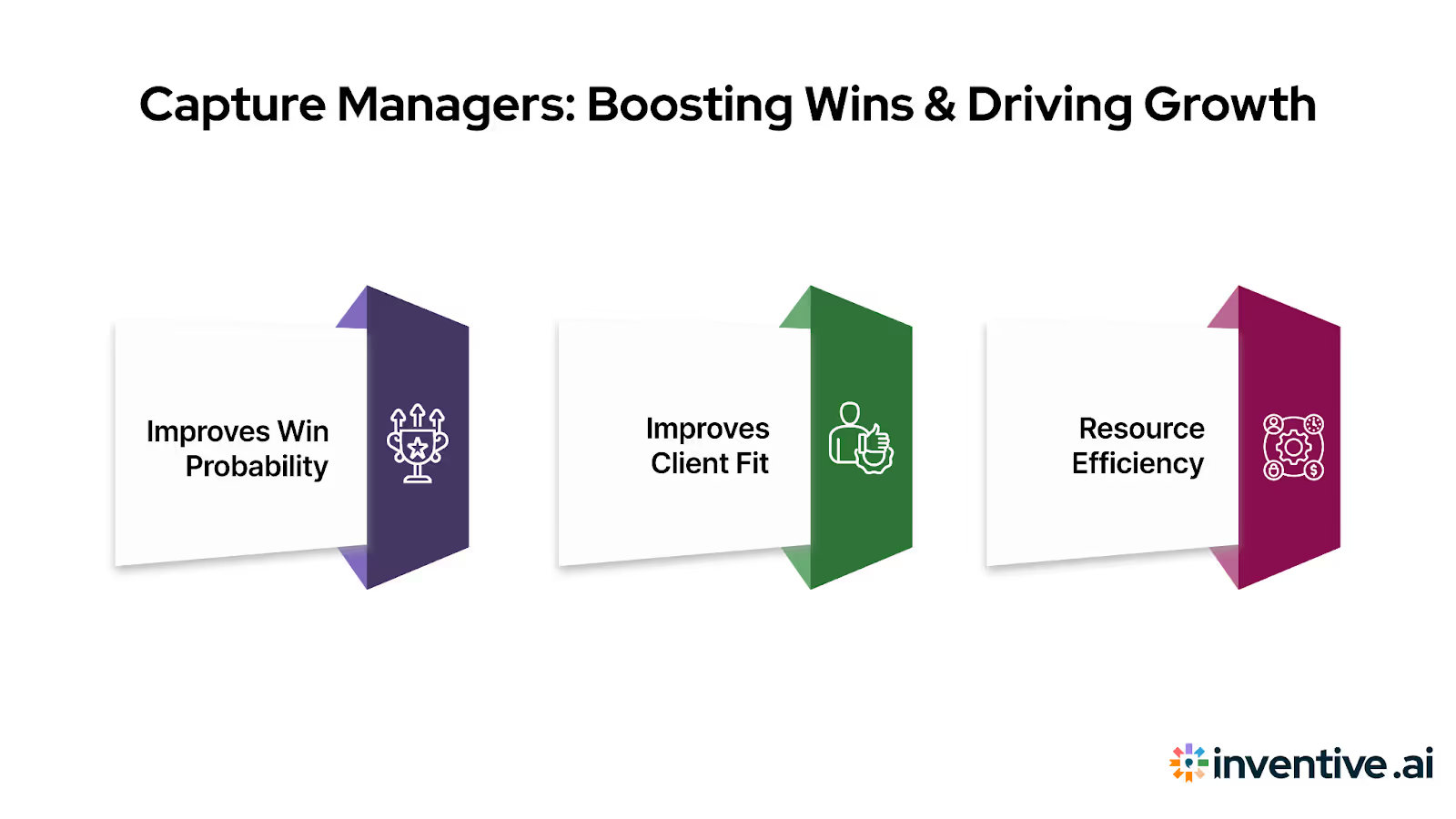What Does a Capture Manager Do? A Complete Guide for 2025
Understand the role of a capture manager in 2025, from identifying opportunities to crafting strategies and aligning teams for better win outcome

Why do some companies win high-value government bids while others miss out?
Many lose because they lack early planning or a deep understanding of opportunity fit. Studies show that 75% of firms win fewer than 50% of government contracts, largely due to inconsistent pre‑RFP activities.
In 2025, as procurement cycles grow more complex, the role of the capture manager becomes essential for revenue-focused teams pursuing enterprise or federal contracts. These professionals focus on opportunity qualification, competitive positioning, and relationship building, long before a formal RFP lands. Their strategic work creates clarity, aligns internal teams, and sets the tone for a strong response.
In this guide you will learn who a capture manager is, their top responsibilities, needed skills, how they differ from proposal managers, and how they can drive business growth in complex sales environments.
Key Takeaways
- A capture manager leads opportunity pursuit from early qualification to pre-RFP strategy.
- They connect sales, operations, and proposal teams to align goals and increase win rates.
- Core responsibilities include opportunity scouting, win strategy, and team engagement.
- Strong communication, research, and planning skills are essential for success in this role.
- Organizations with dedicated capture managers see higher win rates and more efficient deal cycles.
What is a Capture Manager? Understanding the Role and Purpose
A capture manager plays a strategic role in shaping how a company wins complex deals, especially in government contracting and large enterprise sales. Their core purpose is to improve win probability by guiding the pursuit before an RFP is even released. They work behind the scenes to align internal teams, shape customer perceptions, and identify gaps long before a proposal is drafted.
They act as the strategic bridge between sales, delivery, pricing, legal, and proposal teams, ensuring everyone is working toward the same goal. Capture managers don’t just chase bids. They choose the right ones to pursue, gather intelligence on decision-makers, and refine the value proposition based on buyer needs.
From early opportunity spotting to pre-RFP engagement, they take ownership of the strategy, positioning the business for a stronger, more confident proposal phase.
But, when should you consider capture management? Let’s discuss.
When Should You Use Capture Management?
Not every opportunity requires a capture strategy, but for high-stakes deals, it’s a game-changer. Capture management is most useful when the effort, competition, or complexity justifies early planning and cross-team alignment. It helps businesses invest their time where it counts and improve their chances of winning.
Here are common scenarios where a capture manager adds strong value:
- Pursuing high-value or strategic deals where the win probability must be increased through early influence.
- Competing for government contracts, especially those requiring deep compliance and pre-RFP engagement.
- Entering a new market or industry vertical and needing customized positioning and intel.
- Selling to large enterprises with long sales cycles and complex buying committees.
- Responding to sole-source or limited-competition opportunities where relationship-building matters most.
- Aligning multiple departments, like sales, technical, and legal, toward a unified win strategy.
- Improving bid/no-bid decisions by gathering better intelligence early in the deal cycle.
These moments benefit from a focused, pre-proposal strategy, making capture management a smart investment well before the RFP lands.
Understanding this role helps explain why their work is important to winning more and wasting less. Let’s look at what they’re responsible for.
Top 5 Responsibilities of a Capture Manager

A capture manager is responsible for steering the deal before the proposal team gets involved. Their work sets the tone and direction for everything that follows. They gather insights, shape strategies, and make critical decisions that determine whether a pursuit is worth the effort. Every move is tied to improving the odds of winning.
Here are five responsibilities they manage across every strategic pursuit:
- Opportunity Identification and Qualification
A capture manager doesn’t wait for the RFP; they focus on early-stage opportunities. Their job is to monitor agency forecasts, attend industry briefings, and build agency relationships to identify the right deals.
Once spotted, they assess if the opportunity aligns with company goals, strengths, and contract history. This sharp focus avoids wasted effort and resources on poor-fit bids.
- Competitive Intelligence Gathering
Winning isn’t just about what you offer; it’s about knowing who you’re up against. Capture managers study past award patterns, contract deliverables, incumbent performance, pricing models, and key decision-makers.
They map out the competitive field and gather insights that help shape how the company positions itself. This intelligence helps neutralize threats and highlight your differentiators.
- Building the Win Strategy
Once the opportunity is qualified, the capture manager leads the creation of the win strategy. It includes defining key messages, proof points, and customer pain points to target. They also coordinate ghosting strategies and influence buyer perceptions during pre-RFP engagement.
A well-built win strategy ensures the proposal team starts with clarity and intent, not guesswork.
Also, read our informative guide on “How to Master RFP Wins with Strategic Tips.”
- Team Alignment & Stakeholder Engagement
Capture managers work across sales, pricing, operations, and proposal teams. They ensure everyone is aligned on timelines, priorities, and solution approaches.
Managers coordinate executive involvement, gather internal feedback, and build internal momentum around the opportunity. Without this alignment, even a strong proposal can fall apart from within.
- Capture Plan Execution and Readiness Reviews
They create a capture plan, a detailed roadmap for engaging the buyer, prepping the team, and shaping the offer. Along the way, they lead readiness reviews to track progress and fix gaps.
These reviews cover win themes, competitor updates, team roles, and timelines. It’s how they make sure the business is ready to win, not just respond.
Together, these responsibilities show how capture managers drive focus, reduce bid risk, and raise the win rate. Now, let’s look at what it takes to succeed in this role.
Struggling with complex bids?
Streamline your capture process and boost win rates with Inventive AI.
Book a demo now to see how we can help you win smarter!
How to Become a Capture Manager? Key Skills and Qualifications You Need in 2025

Capture managers need more than technical knowledge; they need the mindset to lead long sales cycles and guide teams through high-stakes pursuits. As buying processes become more complex in 2025, strong skills in strategy, communication, and leadership are essential. The role blends commercial insight with people management and deal strategy.
Here’s what sets a top capture manager apart:
Core Skills
- Strategic Thinking: They must see the big picture, how the opportunity fits business goals and where the client is heading. It’s about defining how to win, not just how to compete.
- Market Research: Capture managers dig deep into agency priorities, competitor strengths, past contracts, and funding cycles. This research shapes win themes and pricing decisions early.
- Cross-Team Communication: They work across departments, making sure sales, pricing, ops, and proposal teams stay aligned. Clear and consistent communication reduces delays and confusion.
- Leadership: They drive timelines, set expectations, and push for accountability. Their leadership sets the tone for internal momentum, especially during long pursuits.
- Client Understanding: Capture managers must understand client goals, challenges, and buying triggers. It’s how they influence before the RFP and customize the strategy around real buyer needs.
- Soft Skills: Empathy, active listening, negotiation, internal persuasion, and adaptability.
- Hard Skills: Pipeline tracking, opportunity analysis, proposal reviews, CRM use, and budget planning.
Common Qualifications Required
- Bachelor’s degree in business, marketing, or a related field.
- 5–10 years in sales, business development, account management, or consulting.
- Certifications such as APMP or Shipley training are highly valued in competitive sectors.
A great capture manager is part strategist, communicator, and coach. With these qualifications in mind, it’s helpful to compare how the capture manager role differs from that of a proposal manager.
Capture Manager vs Proposal Manager: 7 Key Differences
Capture and proposal managers are often confused, especially in sales-driven or government contracting environments. While both contribute to the bid process, their goals, timelines, and impact differ widely. One shapes the strategy; the other shapes the response. Understanding how they complement each other is crucial to building a winning team.
Here’s a clear breakdown that shows how their roles compare:
Capture managers lead with foresight; proposal managers deliver with precision. Together, they move the deal forward with both strategy and structure.
Let’s now look at how capture managers directly influence win rates and revenue outcomes.
How do Capture Managers Boost Win Rates and Drive Business Growth?

Every deal is a resource investment. When competition is tight, strategy makes that investment worthwhile. That’s where capture managers help early. They reduce bid risks, align priorities, and shape deals worth chasing. The result? Smarter bids and better outcomes.
Here’s how their role drives measurable business impact:
1. Improves Win Probability
Capture managers increase win rates by shaping the opportunity before the RFP is even released. They study buyer intent, gather intel, and engage decision-makers early.
Organisations with a dedicated capture process report win rates up to 50% higher than those without. It’s not just about bidding; it’s about preparing to win before the competition starts.
2. Grows Deal Size and Improves Client Fit
Instead of chasing everything, capture managers help teams go after deals with real value. They align pursuits with long-term goals, making sure each bid fits the client’s needs and the company’s strengths.
That alignment often leads to larger contracts and longer relationships. In federal contracting, 70% of organizations that execute strategic capture planning have been shown to have higher revenue growth compared to those that don’t.
3. Drives Resource Efficiency
Without clear capture leadership, teams waste time on unqualified bids. Capture managers end that. They prioritize high-fit opportunities and allocate resources wisely. It reduces rework, last-minute rushes, and budget overreach.
Companies with structured capture reviews spend less on failed pursuits. This frees teams to focus on opportunities that convert.
A strong capture function helps win better deals faster and with fewer wasted hours. But the role isn’t without hurdles. Let's look at the common challenges capture managers face and how to overcome them.
5 Common Challenges Capture Managers Face and How to Fix Them
Even the best capture strategies can break down if internal hurdles slow progress. Capture managers often deal with competing priorities, missing data, and limited time, all while being expected to deliver perfect bids. These challenges are not always in their control, but how they’re managed can shape the success of every pursuit.
Here are five common roadblocks and ways to solve them:
1. Incomplete Intelligence
Pursuing a bid without the full picture is like trying to win a race blindfolded. Many capture managers struggle to get early access to buyer insights, competitive data, or stakeholder preferences. It leads to poor bid decisions.
Solving this means investing in pre-RFP intelligence tools, setting up systematic intel tracking, and training BD teams to feed timely information into the capture cycle.
2. Cross-Functional Misalignment
When sales, proposal, and delivery teams don’t align, the entire pursuit effort suffers. Messaging gets inconsistent, deadlines slip, and solutions fall short.
To fix this, organizations need a standardized capture framework that assigns clear roles early. Weekly syncs, shared pursuit platforms, and collaborative pre-bid workshops can align all teams behind a single strategy.
3. Tight Timelines
Last-minute RFPs leave no room for strategy. Many capture managers are looped in too late to shape a strong approach. This reactive model leads to rushed bids and lower win chances.
The fix lies in early pipeline visibility. When capture managers are involved during lead qualification, they gain time to build the win plan well before deadlines hit.
4. Manual Planning and Documentation
Spreadsheets, emails, and fragmented notes make pursuit management slow and error-prone. Many capture managers spend hours tracking tasks instead of focusing on strategy.
Automation and AI-driven platforms solve this by centralizing planning, templates, stakeholder input, and reviews. With fewer manual updates, managers can focus on strengthening the bid.
5. Burnout from Too Many Pursuits
Without filters or prioritization, capture managers often handle too many deals at once. It spreads their attention thin and lowers overall bid quality. To fix this, leadership must enforce opportunity qualification gates.
Automating pursuit scoring and using clear no-go criteria can help teams focus only on high-probability bids that deserve attention.
Challenges in capture management are common, but they’re fixable with the right tools and processes.
One of the most promising solutions? AI-driven support built to optimize pursuit strategies before bids even begin.
Frustrated by slow, disjointed capture workflows?
Discover how Inventive AI centralizes your strategy and team efforts.
How Does Inventive AI Help Capture Managers Win Smarter in 2025?
Inventive AI is built for vendors chasing complex deals, especially in government, B2G, and enterprise sectors. It focuses on pre-RFP capture activities, helping teams get ahead before the bid drops. Instead of juggling emails, notes, and missed insights, managers use Inventive AI to run a structured, faster, and smarter pursuit process.
Here’s how Inventive AI supports every key part of the capture lifecycle without adding to your workload:
- Centralized Knowledge Hub
No more scattered files and email chains. Inventive AI creates a single workspace where capture notes, past proposals, client info, and win themes live together. This hub ensures your strategy is always based on accurate, shared knowledge visible to all stakeholders involved in the pursuit.
- Competitive Intel Assistance
Inventive AI helps you gather and structure competitor insights by opportunity. You get contextual prompts to track likely incumbents, teaming strategies, pricing patterns, and customer preferences without spending hours researching. The result is a stronger, more customized win plan every time.
- Drafting Strategy Docs
Our tools help generate pre-RFP documents like call plans, SWOTs, capture plans, and opportunity briefs. It uses your input and company history to generate ready-to-review drafts, saving time while keeping content aligned with your actual go-to-market playbook.
- Win Theme Generator
We turn raw notes and qualification calls into persuasive win themes. It auto-generates value messaging that ties your strengths to customer pain points, making it easier to align internal teams around a single capture message early.
Here's what our clients say:
“Thank you for building this tool. I am so pumped.
Overall, my RFP workflow is SO much faster now with Inventive.
My day was a lot less stressful using get Inventive.”
- Anthony Pukal, Solutions Consultant
Book a strategy call today and see how we help capture managers win more!
Conclusion
In 2025, capture managers are not just behind-the-scenes coordinators. They are strategic operators who shape win strategies, align internal teams, and improve win rates before an RFP even drops. Their role directly impacts deal quality, pipeline strength, and revenue outcomes, especially in high-stakes, competitive sales environments.
With rising pressure to win more with fewer resources, the value of having a skilled capture manager is clearer than ever. They guide teams through the noise, qualify better opportunities, and build stronger foundations for proposal success.
If you're looking to support your capture team with smarter tools, explore how Inventive can help. Our AI-powered RFP response software helps automate capture workflows, generate win themes, and structure opportunity data early, reducing stress while improving win probability.
Book a free demo with Inventive AI and see the future of AI RFP automation, built for capture managers who want to win before the bid.
Frequently Asked Questions
1. Is “capture management” only used in government contracting?
No. While common in government contracting, capture management is also used in enterprise sales, defence, and large B2B deals where long sales cycles and strategic opportunity planning are required.
2. What’s the average salary of a capture manager in 2025?
According to Indeed, the average capture manager salary in the US is $152,113 annually. The range is $104,184 to $222,093. Government and defense sectors typically offer higher compensation.
3. Do startups need a capture manager?
Yes, especially if they pursue high-value government or enterprise contracts. A capture manager helps qualify deals, align teams, and shape winning strategies early, essential for lean startups competing with established players.
4. Can a proposal manager also act as a capture manager?
Yes, in smaller organizations. However, combining both roles may reduce effectiveness. Proposal managers focus on responding to RFPs, while capture managers drive pre-RFP strategy and qualification. Distinct roles enhance focus and results.
5. What tools do capture managers typically use?
Common tools include CRM platforms (Salesforce), research databases (GovWin, SAM.gov), planning templates, and collaboration tools like SharePoint. Many now use Inventive AI’s AI-powered software to automate capture planning and gather competitive intelligence.


